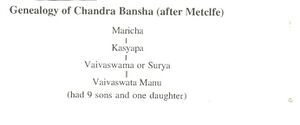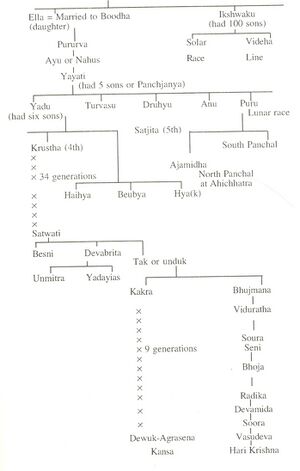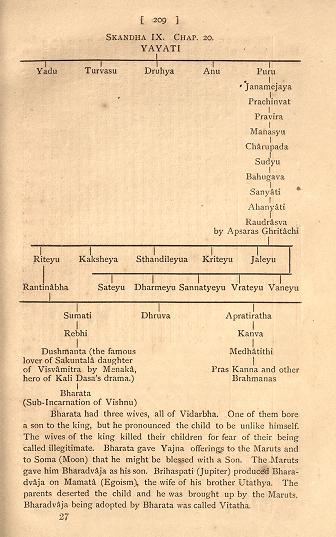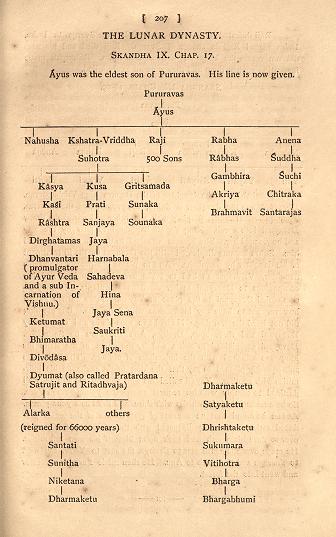Chandravansh
| Author:Laxman Burdak, IFS (R) |


Chandravansh (चंद्रवंश) Chandravanshi (चंद्रवंशी)[1] [2] is one of the types of Kshatriyas. James Tod places it in the list of Thirty Six Royal Races.[3]
Variants
- Chandravansh (चंद्रवंश)
- Chandravanshi (चंद्रवंशी)
- Somavamsa (सोमवंश)
- Somavansha (सोमवंश)
- Somavamsha (सोमवंश)
History
Ram Sarup Joon[4] writes that...When Aryans came to India They called themselves the descendants of Manu and remembered the tragedy of the flood. They came to India in two groups. Their strength cannot be ascertained. One of those advanced straight through the northern plains and founded the town of Ayodhya. The leader of this group was Ikshwaku, who had eight brothers and one sister named Ahalya (or Ela). On arrival at Ayodhya this group clashed with the original inhabitants and drove them down South. The other group settled down on the banks of River Ganga in the area around Haridwar, and stayed there for many generations. The leader of this group was Buddha (not to be confused with Buddha who founded Buddhist Religion). Buddha married Ikshvaku’s sister Ahalya. In his Dynasty were Pandwa etc (not of Mahabharat age/epic). His son was Nahak and his son Yayati, father of Jats.
Historians of the Rajput period have called the Ikshwaku group as Surya Vanshi and the Buddha group as Chandra Vanshi, corresponding to the Sun and Moon. Their origin has been linked with Brahma the creator of the universe. The following genealogical tree was drawn out.
___________________|_____________________
| |
Suryavansh Chandravansh
| |
Marichi Atriya
| |
Kashyap Samudra
| |
Soma
| |
Vaisuta Manu Brahaspati
| |
Man Vantra
| |
Ikshwaku Buddha
The names included in this table, above Ikshwaku and Buddha are just synonyms of the Sun, Moon and Planets.
Krishna was born in Chandravansh. Several Kshatriya communities/clans claim descent from Chandra. One of Brahma's son was Ādī, whose son was Chandra (Soma), from whom started Chandravansh. [5] Thakur Deshraj writes that those who follow the Lunar calendar for time calculation are Chandravanshi kshatriyas. [6] [7]
According to the historian 'Ram Lal Hala' the word Jat is derived from word 'Yat'. There was a king named 'Yat' or Yata in Chandravanshi clan who was ancestor of Lord Krishna. The Jats are descendants of King Yat. 'Yat' later changed to 'Jat'.
Krishna belonged to this branch of the Chandravanshi of Vrishnis from whom he got the name Varshneya.
The Scythian writer Abul Gazi has called himself a Chandravanshi Jat. He also writes that the mother of Scythian community was the daughter of Aila or Ailya Devi.
According to Thakur Deshraj [8], The Chandravanshi Aryans of India had habitations in Iran which were known as Jatali. He has referred General Cunningham who has mentioned the presence of Yayati Vanshi Jats in Jatali. Yayati was son of Nahusha. This province got the name Jatali being the habitation of Jats. The language of these Jats is Jadgali (alternate names, Jatgali, Jatki, Jat) [9]
Maharaja Bhoj was son of Druhyu, the Chandravanshi Jatvansh King Yayati.[10]
Jat clans from Chandravansh
Atri, Aulakh , Badgujar, Ball, Bhoja, Bochalya, Budhwar, Chandar, Chandawat, Chandel, Chhina, Dahiya, Daral, Gorya, Jakhar, Janjua, Mahla, Malla, Narwar, Nauhwar, Pandav, Parihar, Poras, Punaria Purwar, Rathi, Rathor, Salial, Salkalan, Siag, Sinsinwar, Sogaria, Sohal, Solanki, Tokas, Virdi,
Lunar races in Bhagavata Purana


Atri → Chandrama → Budha → Pururava → Ayu → Nahusha → Yayati
Reference - A study of the Bhagavata Purana; or, Esoteric Hinduism by Purnendu Narayana Sinha, Benares,1901
Bhagavata Purana Skandha IX Chapter 14 tells us about Chandravansh or Lunar races as under:
Page 202
Soma (चन्द्रमा) (the Moon) was born out of the eyes of Atri. He carried off Tara, the wife of Brihaspati (Jupiter). Brihaspati asked for his wife several times, but Soma would not give her up. Sukra (Venus) was not on good terms with Brihaspati. So he took the side of Soma, with his disciples, the Asuras. Siva with his Bhūtas took the side of Brihaspati. Indra with the Devas also sided with their preceptor. The two parties engaged in fight. After some days of fight, Angiras informed Brahma about every thing that transpired. Brahma reproached Soma. So he returned Tara to Brihaspati. Brihaspati found that Tara had conceived. " Immediately throw out the seed of another man in my field," cried he. Tara feeling bashful brought forth at the time a lustrous son, Both Brihaspati and Soma desired
Page 203
to have the son, each saying "it is mine not yours." When they quarrelled with each other, the Devas and Rishis asked Tara who was the father of the child. The child reproved his mother for the delay in answering. Brahma took Tara aside and learned from her that Soma was the father of the son, Soma then took the child. Brahma seeing the deep wisdom Of the child named him Budha (Mercury).
Budha had by Ila one son Pururavas, Narada related his beauty and his virtues to the Devas in Svarga. Urvasi heard all that and took a fancy for the king. By the curse of Mitra Varuna, she had then a human form. Both the king and the Apsaras became attached to each other and they lived as husband and wife. But Urvasi laid down two conditions of her company with the king (i) that the king was to preserve two rams, which the Apsaras had brought with her and (2) that the king was never to expose himself before her except in privacy. Indra sent the Gandharvas in search of Urvasi. They found her out and took away her two rams. She had a maternal affection for these animals and she cried out in despair. The king hurriedly took his arms and ran after the Gandharvas. They left the rams and fled away. The king brought them back. But in the hurry, he had forgot to cover himself and Urvasi left him. The king became disconsolate, and roamed about in search of her. After some days he found her on the banks of the Sarasvati with her 5 companions. He entreated her to come back. She promised to give her company to the king one night every year and informed him of her delicate state of health.
Urvasi came after a year, with one son. She advised the king to entreat the Gandharvas for her hands. The king did so and the Gandharvas became pleased with him. They gave him one Agni-sthali (pot of fire). The king took the Agnisthali to be Urvasi and roamed with it in the forest (The Gandharvas gave him the fire for the performance of sacrifice necessary for the attainment of Urvasi). The king found out his mistake at last. He then placed the fire in the forest, went home and meditated every night on Urvasi. On the approach of Treta, he was inspired with the three Vedas (Karma-kanda). He then went to the place of fire and found there one Asvatha tree (the sacred fig) grown from inside a Sami tree (Sami is the name of a tree said to contain fire). He decided that the fire must be within the Asvatha tree. He took two pieces of wood (technically called Arani) from that tree and produced fire by their friction. He- deemed one piece to be Urvasi and another piece to be himself and the space between the two pieces to be his son. By friction, the fire called Jata-vedas came out ( Vedas is wealth, enjoyments in general. Jāta is
Page 204
grown. Jata-vedas is that fire from which enjoyments proceed that which gratifies all sense-desires. It is the chief fire of the Karma- kanda of the Vedas). By the invocation of the three vedas, that fire became three fold. (Ahavaniya, Garhapatya, and Dakshina are the three fires perpetually kept in the household. Ahavaniya is the eastern fire which represents the relations of the house holder with the Devas. Garhapatya is the sacred fire which the householder receives from his father and transmits to his descendants and from which fires for sacrificial purposes are lighted. It represents household and family duties. Dakhina is the southern fire. It represents all classes of duty to the Pitris). The king imagined this threefold fire to be his son (The son by his offerings sends his father's soul to Svarga. The sacrificial fire also sends the performer to Svarga). With that fire, he performed Yajna desiring to reach the Loka (plane) of Urvasi. Prior to this in Satya Yuga, Pranava was the only Veda, Narayana was the only Deva, there was only one fire and only one caste. The three Vedas came only from Pururavas, at the beginning of Treta Yuga. The king attained Gandharva Loka by means of the fire. (In Satya Yuga, Satva generally prevailed in men. There fore they were all fixed in meditation. But in Treta Yuga, Rajas prevailed and by the division of the Vedas, Karma Mārga made its appearance. Sridhara)
Page 232
The Lunar races first appeared while the descendants of Ikshvaku were still flourishing, though on the eve of their decline. They had immense possibilities of spiritual evolution, and the great Aryan race seems to be connected with them. The appearance of these races is almost simultaneous with the first flow of the Ganges. For we find Jahnu, who swallowed up the Ganges in her first terrestrial course, is only sixth in the line of descent from Pururavas.
The Lunar dynasty originated in the union of Tārā, the female principle of Brihaspati (Jupiter), and the Moon. The issue was Budha (Mercury), the direct progenitor of the Lunar dynasty.
Page 233
The son of Budha was Pururavas. He married Urvasi, the renowned Deva nymph. Pururavas had six sons. But we are concerned with only two of them, Ayus and Vijaya. Vijaya gave the Adept line of the race and Ayus, the ordinary humanity.
In the line of Vijaya, we find Jahnu, purified by the assimilation of Ganga, Visvamitra, pre-eminently the Rishi of the Rig Veda and one of the seven sages who watch over the destiny of the present Manvantara, Jamadagni, another of the seven sages of our Manvantara and Parasurama one of the coming sages of the next Manvantara.
We have already mentioned the part taken by Visvamitra and his sons in the composition of the Vedic Mantras.
Coming to the line of Ayus, we recognise the forefathers of the Aryan races.
In the short-lived branch through Kshatra-vriddha, we find the Vedic Rishi Gritsamada, his son Sūnaka, the renowned Sounaka, Dirghatamas and Dhanvantari, the promulgator of Ayur-veda.
But the longest history of the Race is through the descendants of Yayati.
King Yayati married Devayani, the daughter of Sukra, the presiding Rishi of the planet Venus, and had by her two sons, Yadu and Turvasu. Sukra is the son of Bhrigu, the Rishi of Mahar Loka. Devayana, is the path leading beyond Triloki, after death.
But the King had also connection with a Danava girl, who brought forth three sons, Druhyu, Anu and Puru. For his Dānava connection, King Yayati had in youth to undergo the infirmities of age. This evil was transmitted to Puru, the youngest son of the Danava girl.
The line of Puru was short-lived. But it is this line that gave some of the renowned Vedic Rishis, viz. Apratiratha, Kanva, Medhatithi and Piaskanva. Dushmanta, the hero of Kalidasa's renowned drama also came of this line. Vishnu incarnated in part as Bharata, son of Dushmanta.
Then there was a revolution. Bharata found that his sons were not like unto himself. So this direct line of Puru came to an end. What followed is a little mysterious. Bharata adopted Bharadvaja as his son. Bharadvaja was begotten by Brihaspati ( Jupiter) on the wife of his brother Utathya named Mamata (Egoism).
Page- 234
Bharadvaja is one of the seven presiding Rishis of the present Manvantara. His name is connected with several Mantras of the Rig Veda.
The great actors in the Kurukshetra battle were the descendants of Bharadvaja. We find much diversity of spiritual characteristics among them. The material and spiritual forces were gathered together, in all possible grades from the Pandavas downward to the sons of Dhritarashtra and their allies. The poetical genius of the author of the Mahabharata has called forth characters in the Drama of the Kurukshetra battle, that stand out in all the details of real life and find a permanent place in the genealogy of the Lunar dynasty. The study of the racial account of the line of Bharadvaja becomes therefore extremely difficult.
The Lunar dynasty will be revived by Devapi, a descendant of Bharadvaja, who is biding his time at Kalapa.
The early inhabitants of Bengal, Behar and Urishya were the sons of Anu, the second son of Sarmistha. The famous Karna, one of the heroes of Kurukshetra, also belonged to this line.
The eldest son of Sarmistha by Yayati was Druhyu. Prachetas of this line had one hundred sons, who inhabited the north as Mlechha races.
But the greatest interest attaches to the line of Yadu, the eldest son of Yayati by Devayani. The early descendants of this line were the Haihayas, killed by Parasurma, and the Taiajanghas, killed by Sagar - both of the Solar Dynasty. The Mahabharata has given an importance to the overthrow of these early Yadu classes as a victory of the Brahmanas over the Kshatriyas. Next to the Brahmanas in intelligence were the Kshatriyas. They eagerly accepted the teachings of Rama, who incarnated as one of them. They knew Isvara as higher than the Devas and the Brahmanas. They thought they could profitably employ their time in seeking after the knowledge of Brahman. This necessarily offended the orthodox Brahmanas, who performed the Vedic sacrifices and had no higher ambition than to resort to Devaloka. The Kshatriyas thus represented a religious evolution, of which the Upanishads were an outcome. In time, some Brahmanas even became disciples of Kshatriyas. Both Rama and Krishna incarnated themselves as Kshatriyas. We are to understand that by Kshatriyas, during this period of Puranic history, is meant seceders from Vedic Karma KAnda more or less,
Page - 235
The early seceders, the Haihayas and Talajanghas were put down by the Brahmana Parasurama and by the Kshatriya King Sagar, who espoused the cause of Vedic Karma Kanda and of the Brahmanas, represented by Rishi Aurva of this time.
Parasurama did not like any meddling with Vedic Karma Kanda by persons not perfected in wisdom. Even Rama had to respect the Vedic Rishis and had to protect them in the performance of Vedic sacrifices from the attacks of Asuras and Rakshasas. When Lord Krishna appeared on the scene, the Asuras still survived ; the Vedic Rishis denied offerings to Him, Vedic Karma had a strong supporter in Jarasandha, there was hypocrisy in the name of religion, and there were pretensions in various forms. On the other hand great improvements had been made in the proper understanding of the realities of life and of the laws of nature. Intellect overflowed in many channels of thought, and the religious nature of man found vent in all directions from atheism to religious devotion.
See also
References
- ↑ Jat History Dalip Singh Ahlawat/Parishisht-I, s.n. च-17
- ↑ Dr Ompal Singh Tugania: Jat Samuday ke Pramukh Adhar Bindu, p.37, sn-697.
- ↑ James Todd, Annals and Antiquities of Rajasthan, Volume I,: Chapter 7 Catalogue of the Thirty Six Royal Races, p. 99
- ↑ History of the Jats/Chapter II,p. 20
- ↑ Bhaleram Beniwal: Jāton kā Ādikālīn Itihāsa, Jaypal Agencies, Agra 2005.
- ↑ Thakur Deshraj: Jat Itihas, p. 138
- ↑ CV Vaidya, History of Medieval Hindu India
- ↑ Thakur Deshraj: Jat Itihas
- ↑ http://www.ethnologue.com/show_language.asp?code=jdg
- ↑ Mahendra Singh Arya et al.: Adhunik Jat Itihas, Agra 1998, p, 274

